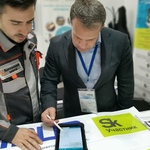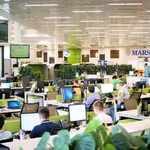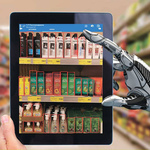The Digital Economy Development Institute (DEDI LLC), a resident of the Skolkovo Foundation information technology cluster, presents the OPTIMUM SmartLook Retail software image recognition system (OPTIMUM SmartLook Retail) that uses artificial intelligence technology to automatically recognize images on a mobile device.
The software solution that has been developed on the basis of the OPTIMUM SmartLook Engine Digital Platform (OPTIMUM SmartLook Engine) using proprietary techniques and recognition engine offers unique advantages to merchandisers of the companies that manufacture and distribute Fast Moving Consumer Goods (FMCG).
OPTIMUM SmartLook Retail enables you to speed up filling out merchandising documents by analyzing the compliance of product location with the planogram, determining the correctness of price tags, and checking relevance of numerous POS materials including light panels, shelf talkers, price holders, wobblers, stoppers, promotion counters, dispensers, and other equipment.
The most important feature that differentiates OPTIMUM SmartLook Retail from existing programs is the ability to recognize and analyze images from photos on a mobile device in real time and without an Internet connection. The quality of merchandiser operations is highly dependent on the recognition speed, and when operating a cloud service wherein in this process usually occurs, the type, coverage, and cell network loading are of significant importance. The cost of traffic should also be taken into account, which increases due to the transfer of large-volume photos to the server and back. The recognition in a mobile device does not involve unnecessary time losses and financial costs.
However, the most significant difference between OPTIMUM SmartLook Retail and its competitors is not just detection of mismatches between a realogram and a planogram, but also prompt issuance of recommendations to the merchandiser on how to eliminate deficiencies and plan supplies. Based on the sales history for a certain period, the OPTIMUM ISUMT sales force automation system, into which OPTIMUM SmartLook Retail can integrate, automatically generates an order for the missing amount of products and sends it to the supervisor for approval. Consequently, automatic re-ordering enables an increase in sales and reduction in costs (for example, the number of expired or spoiled products is reduced).
Ann important task in addition to checking planograms and re-ordering products in retail chains is to control changes in price tags. Several days are needed in a typical situation to update price tags in conducting a sale promotion in a large nation-wide network. This problem leads to conflict situations in stores, customer complaints, disputes with suppliers, damaged reputation of the entire network and, eventually, to losses of profit. The OPTIMUM system solves this problem by quickly delivering reliable information about the mismatch between recommended prices specified in the store database and price tags in the display area. The system uses algorithms that support various schemes of managing loyalty programs that are often used in retail, for example, “multi-level” pricing.
The OPTIMUM SmartLook Retail solution can be implemented as part of the OPTIMUM ISUMT (most advanced employment of analytic capabilities, forecasting. and data storage) or as a standalone software solution with a cloud service database or integrated with corporate information systems, such as 1C, Oracle, etc.
In addition to amazing accuracy (the rate of correct identification of products on shelves was in the pilot project as high as 98%) and the operation speed, OPTIMUM SmartLook Retail features low requirements for the characteristics of the smartphones used for taking photos. Owing to this, this software can be quickly and inexpensively launched using a relatively old fleet of mobile devices operated by merchandisers and sales representatives.
The OPTIMUM SmartLook Engine digital platform will be enhanced in 2019-2020 to recognize people, in particular, to assess the flow of visitors in stores and other public places and analyze faces (moods) and customer behavior in stores. The capacities of this solution are really immense. The system will “highly impress with artificial intelligence” not only retail but also other sectors of the economy. Automation of maintenance and repair of industrial equipment with the involvement of machine vision systems is the priority in product development.






